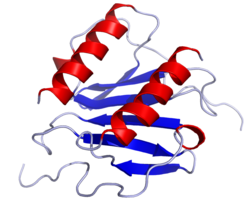Interleukin 8 (IL-8 or chemokine (C-X-C motif) ligand 8, CXCL8) is a chemokine produced by macrophages and other cell types such as epithelial cells, airway smooth muscle cells[3] and endothelial cells. Endothelial cells store IL-8 in their storage vesicles, the Weibel–Palade bodies.[4][5] In humans, the interleukin-8 protein is encoded by the CXCL8 gene.[6] IL-8 is initially produced as a precursor peptide of 99 amino acids which then undergoes cleavage to create several active IL-8 isoforms.[7] In culture, a 72 amino acid peptide is the major form secreted by macrophages.[7]
There are many receptors on the surface membrane capable of binding IL-8; the most frequently studied types are the G protein-coupled serpentine receptors CXCR1 and CXCR2. Expression and affinity for IL-8 differs between the two receptors (CXCR1 > CXCR2). Through a chain of biochemical reactions, IL-8 is secreted and is an important mediator of the immune reaction in the innate immune system response.
- ^ a b c GRCh38: Ensembl release 89: ENSG00000169429 – Ensembl, May 2017
- ^ "Human PubMed Reference:". National Center for Biotechnology Information, U.S. National Library of Medicine.
- ^ Hedges JC, Singer CA, Gerthoffer WT (July 2000). "Mitogen-activated protein kinases regulate cytokine gene expression in human airway myocytes". American Journal of Respiratory Cell and Molecular Biology. 23 (1): 86–94. CiteSeerX 10.1.1.326.6212. doi:10.1165/ajrcmb.23.1.4014. PMID 10873157.
- ^ Wolff B, Burns AR, Middleton J, Rot A (November 1998). "Endothelial cell "memory" of inflammatory stimulation: human venular endothelial cells store interleukin 8 in Weibel-Palade bodies". The Journal of Experimental Medicine. 188 (9): 1757–1762. doi:10.1084/jem.188.9.1757. PMC 2212526. PMID 9802987.
- ^ Utgaard JO, Jahnsen FL, Bakka A, Brandtzaeg P, Haraldsen G (November 1998). "Rapid secretion of prestored interleukin 8 from Weibel-Palade bodies of microvascular endothelial cells". The Journal of Experimental Medicine. 188 (9): 1751–1756. doi:10.1084/jem.188.9.1751. PMC 2212514. PMID 9802986.
- ^ Modi WS, Dean M, Seuanez HN, Mukaida N, Matsushima K, O'Brien SJ (January 1990). "Monocyte-derived neutrophil chemotactic factor (MDNCF/IL-8) resides in a gene cluster along with several other members of the platelet factor 4 gene superfamily". Human Genetics. 84 (2): 185–187. doi:10.1007/BF00208938. PMID 1967588. S2CID 2217894.
- ^ a b Brat DJ, Bellail AC, Van Meir EG (April 2005). "The role of interleukin-8 and its receptors in gliomagenesis and tumoral angiogenesis". Neuro-Oncology. 7 (2): 122–133. doi:10.1215/s1152851704001061. PMC 1871893. PMID 15831231.




